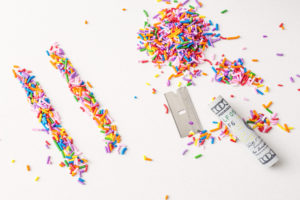Hi, my name is Leslie, and I’m an emotional eater. When I’m feeling off my rocker, it’s my natural inclination to turn to food. I realize this isn’t a cool problem to have, but it’s mine and it doesn’t appear to be going anywhere anytime soon.
What I can tell you is that that I’ve gotten much better at managing it. To the point, that it’s almost nonexistent for me now. The key word being almost. I’m not sure this will ever be something that completely escapes me, but I’ve learned how to make friends with it. Err… let’s try that again: l’ve learned how to live with it. On most days.
I’m not going to bullshit you. I still have the occasional slip-up where I mindlessly reach for a 10,000 calorie slice of cheesecake to distract myself from an uncomfortable situation or feeling. Like most individuals, I’m not always ready to play Dr Phil and dig into the source of my discomfort in the heat of the moment. Sometimes, I just want it to go away, and I want it to go away NOW. No matter what it takes. I’ll deal with the aftermath later.
But the thing is, that aftermath sucks twice as hard as the situation that put me there in the first place. Sure, it may relieve me of some temporary stress in the moment, but when I finally build up the courage to confront those icky feelings head on, it’s a lot less scary to do so without the addition of guilt and shame sprinkled on top.
And honestly there’s not a single problem that I’ve ever encountered that a helpless box of unsuspecting Girl Scout cookies was ever able to cure for me. This was my shit. And until I owned it whole-heartedly, it would continue to have control over me.
But this is where it gets messy. Because humans are messy. And life is messy.

Food obsession, food anxiety, and emotional eating are all common issues that rarely get the attention they deserve. And I attribute that to the fact that most people are carrying this burden cloaked in shame. This isn’t the kind of thing you celebrate with balloons or discuss with the other PTA parents at the monthly meeting.
Despite the fact that almost all of us have a dysfunctional relationship with food on some level (why else would you be reading this?), these behaviors in particular are served alongside a big heaping pile of guilt and embarrassment. And because no one is talking about it, we feel as though there must be something wrong us. We must be alone in our struggle.
So, how do we cope? We hide our feelings. And we hide our food. And we try to hide our feelings underneath our food.
It’s in our heads.
Before we can understand how to make it stop, we first have to understand how it starts.
We eat because it calms us. We use food as a tool for comfort. It soothes us. It’s relaxation. It’s celebration. And it’s fun…until it isn’t.
In the end, using food as a way to escape reality isn’t all that fun after all, is it?
By now you’ve probably heard of the brain chemical dopamine. It’s that warm ’n fuzzy feeling we get when everything is going alll riiiggghhht. It drives the pleasure and reward centers in our brain. This can be experienced a number of different ways: food, exercise, sex, drugs, rock ‘n roll, etc. It’s the stuff that makes us feel good — and jonesing for more.
In the words of Jill Coleman, “The problem with dopamine release is that we experience it more fully when we’re engaging in pleasure-seeking behaviors. Often the same behaviors that prioritize instant gratification over long-term success.” And unfortunately, the more we consume the object of our affection, the higher our tolerance becomes, so we become desensitized to it and require more “hits” to achieve the same level of euphoria as before. This may explain why you used to be able to eat one fun-sized candy bar and feel satisfied, but now you require two to reach the same state of contentment.
Keeping that in mind, the most effective way to break yourself from this cycle is to stop reinforcing it altogether.
Easier said than done, right?
So is the answer to slap the donut out of your hand mid-bite? Ideally, yes. But the notion that we’re never going to eat sugar again is completely unrealistic and inconceivably short-sighted.
So, what can we do? Practice controlled eating. And yes, it requires diligent practice. It’s not something you just get; you have to work for it. And it may take a long time, but you will get there if you persevere and don’t give up.
It’s a habit.
So what can we do?
Practice controlled eating. And yes, it requires a lot of practice. It’s not something that just “clicks” in a matter of days; you have to be determined and willing to keep at it. And it may take a long time, but you will get there if you persevere and don’t give up.
In a nutshell: it has to become a habit.
Like most of our behaviors, our desire for certain foods are often the result of our daily routine. And habits, by definition, aren’t really things we think about. They’re effortless. They’re the path of least resistance, so it’s no surprise we’re not always mentally aware of the decisions we’re making along the way.
It usually looks a little something like this:
It’s Friday! Whew. End of the work week. Happy hour! Time to eat, drink, and be merry.
Oh, well hello there, Sunday. Football watching day. Bring on the hot wings and beer!
What’s that you say, Tuesday? The 3pm work day slump has you feeling tired? You’d better go get your hands on a Snickers bar at the vending machine. We wouldn’t want you to fall asleep on your desk again.

I know I’ve been guilty of this in the past. Just recently I noticed an old childhood ritual pop-up when I went home to visit my Mom.
I kid you not; I may as well have been Pavlov’s dog, because as soon as I hit the threshold, I mindlessly walked right over to the fridge and began assessing its contents. Hungry or not, it would have made no difference. This was a thirty year-old habit at play and I was so unaware of what I was doing that I may as well have been hypnotized. As a kid, coming home from school and immediately digging through the fridge had become such a part of my daily routine, that here I was thirty years later continuing to reinforce the same patterns that got me here in the first place.
But making this discovery didn’t happen over night. We all have our individual cues, triggers, and routines. It takes time to observe and become aware of these practices before we’re ever able to troubleshoot and then adjust them. The end goal, of course, being that we either choose a healthier alternative or skip the ritual altogether. And it starts with looking inward.
Am I really hungry? Do I want something to eat because I’m feeling anxious? Am I bored? Tired? Thirsty?
Or, you could try changing your routine entirely. Maybe your hang-up is hitting the drive-thru and grabbing a McDonalds blizzard on your way home from work every day.
Instead, you could practice traveling a different route to avoid the McDonalds, or substitute the blizzard for a lower calorie ice cream cone. And then you could slowly transition to getting the ice cream cone every other day, and then eventually every three days, etc.
It’s a band-aid.
At the end of the day, whether you’re eating because you’re craving certain foods — you’re eating because there’s a deeper issue that needs your attention.
That’s all emotions are, by the way — little body cues that let you know that there’s something inside of you that needs a little maintenance. And despite repetitive efforts, trying to drown it in your favorite alcohol of choice it isn’t an effective strategy. Trust me, I’ve tried.
So what do we do?
Well, we learn to do be comfortable with the uncomfortable. We look inward. And then after careful observation. We be compassionate with ourselves and then we slowly begin to face the issue head-on.
Before we can make these uncomfortable feelings go away, we have to identify was caused them in the first place. And then look for a way to soothe ourselves without all of the high calorie ice cream.

If you’re caught in the middle of a binge or craving, try to find a temporary distraction until you’ve had a chance to let the dust settle. Maybe it’s going for a walk, reading a book, or calling a friend.
Arm yourself with that distraction until your cravings have calmed down and you’re ready to address the core of what’s causing your emotional discomfort.
Is it your job? Your relationship? Your kid’s incessant need to say, “Mom, mom, mom, mom, mom…” while banging on the door when you’re in the bathroom?
The goal is to find a way to remove yourself from the stressful situation and settle into a healthier way to manage the anxiety.
Practice eating in a way where you don’t feel deprived of your favorite foods, but you’re also not eating everything in sight. Make sure you’re eating ALL the foods you love, but stopping before you get too full or uncomfortable. And then wait until you’re hungry to eat again.
This takes conscious effort. It’s not a quick-fix or something that you’re going to master right away. You have to be aware of your triggers, cues, and routines before you’ll have any success in changing them. Monitor your behavior in high-stress situations. And then assess how you can adapt those to be more manageable in the future.
But above everything else, be prepared to practice patience and self-compassion. And failure. A lot of failure. Expect it. Plan for it. Fail a thousand times, but whatever you do — don’t give up. Keep going and with time, it will get easier.
If you feel like you need some additional help or just want to have a chat with someone who gets it, contact me. You don’t have to continuing living in shame. There’s nothing wrong with you. You’re doing the best you can. And that’s good enough.

